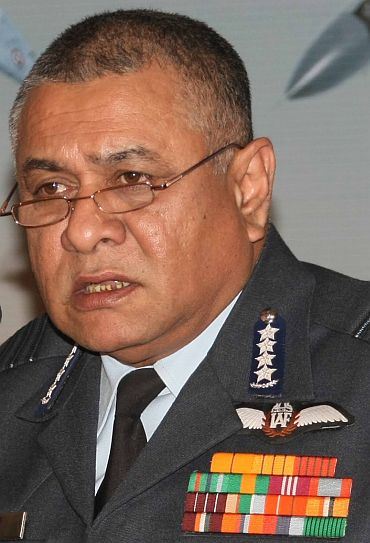
These are exciting times for the Indian Air Force after battling years of obsolescence and depleting fleet strengths, it is now poised for a major transformation. What does the future hold?
In an interview to Nitin Gokhale, Security & Strategic Affairs Editor at NDTV, Chief of Air Staff Air Chief Marshall P V Naik discusses his strategy for the transformation of the IAF.
Let me start by asking you what are the changes that are being done in the Air Force for the past 3- 4 years and what do you think is going to happen in the next 3-4 years?
The process of change started 7 or 8 years back, but it is materialising now, which is a very very exciting thing. Over the next 3-4 years, I expect the IAF to become one of the most modern air forces in the world.
There are lots of things in the offing -- we have aircrafts, equipment, missiles, radars actually we have a very long list. If you permit me I will just read out from this just to tell you what all inductions we have planned.

There are upgrades also going on for weapon systems: 63 MiG-29's, that upgrade is well on its way in Russia. Mirage 2000 upgrade will be going to the CCS next week and Jaguar re-engineering, that is another major project for which a new RFP has been issued now.
Missiles, 18 firing units of Medium Range Surface to Air Missiles, 4 Spyders , 49 SR-SAM that is short range,8 Aakash missiles.
As far as radars are concerned, Rohinis, aerostats, medium-power radars, low-level tactical radars, low-level light weight radars, we have the AFNET, which is already active. We have the Modernisation of Airport Infrastructure, which is going on. The first airfield to convert on to MAFI would be Bhatinda.
So if you see all-round development of the Air Force is in the offing.
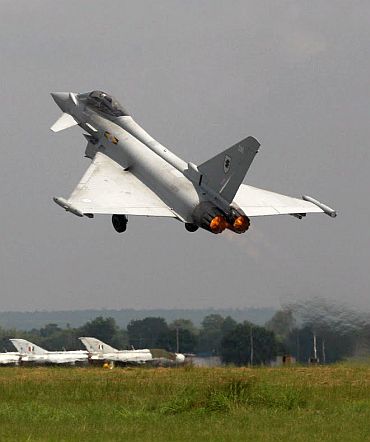
Some of the deals are always in focus for example, the 126 fighter jets, it's been a long process and you have had a technical re-evaluation, flight testing and now you have come down to two manufacturers. There has been a lot of speculation, a lot of writing on this -- that the Americans and the Russians were very unhappy and that they in fact went to the extent of saying some of the processes were unfair they were not transparent enough. What do you have to say to that?
Right in the beginning when this deal was going through, I had said that whoever we select, the others would always be dissatisfied. As far as the entire process of the MMRCA selection is concerned, I think it is one of the finest things the Air Force has ever done.
There was no security breach, a very fair treatment was given to everybody, every vendor briefed as per RFP and in fact the process has gone so well and so timely that I would like to patent that process. After all these were six of the best aircraft in the world.
Unnees-Bees ka farakh, very little difference in all these; very difficult to decide which is the best, ultimately what suits our country -- the best has to emerge as the best.
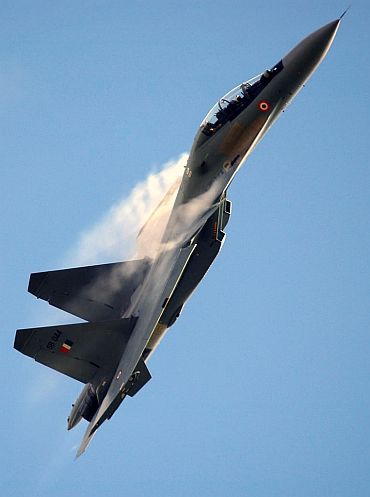
That doesn't mean the other aircraft are bad. But these were the best-suited to our conditions and so that is how we went about the selection. The process was very elaborate. As you are aware each aircraft had 600 testing points. So the whole thing went through in a very professional manner and I must compliment the team that undertook this task --very well done.
In any case I think and the others have pointed out that this is not the only deal that is going in the Air Force, you have several others. Like the Americans shouldn't be complaining about not getting this deal because you are giving them other orders. For instance the C-17s, the C-130s and Harpoon missiles you are buying from them. Even the Russians -- you have a major project with them isn't it?
Yes, we have the fifth-generation fighter aircraft, we have the Brahmos missile which is a joint project .And we have many others.
Sukhoi upgrade also, I mean the additional Sukhois?
The Sukhoi upgrade, the MiG-29 upgrade so many things for the Russians also.
So everybody can actually get a part of the pie in India?
We have selected whatever is best for us. It so happens that it is well-distributed.

Coming back to the final selection, what do you think is the time frame? You had said before that it should be done very quickly. Is there a time frame you could think of?
At present, the Technical Oversight Committee has finished their report. The report will be submitted to the Rakhsha Mantri. Thereafter, they will open the commercial bids and decide who is the L-1 (lowest bidder) vendor. After that the CNC will start negotiations, thereafter it will go to the Finance Ministry. From Finance, it will go to CCS and after their approval, the final contract will be signed.
So I think another two months is a very optimistic assessment. By September, I expect this deal to be signed.
And once the deal is signed, what is the time frame for the induction of the first aircraft?
That will be about three years.

One way of overcoming over-dependence on foreign vendors or foreign manufactures is to indigenise. We have had this experience of the LCA Tejas. You have inducted the prototype, given operational clearance for the first prototype. How hopeful are you about the LCS Tejas finally getting inducted and coming into the IAF?
See Tejas took us 20-21 years to reach this stage, but over the last two years I have seen that we have reached a very good stage and there is light at the end of the tunnel.
And I am very very positive that Tejas will be inducted into the Air Force. We have already given the initial operational clearance. Now the squadrons will slowly come and start operating these aircrafts. It will take a couple of years for these aircraft to get full operational clearance.
During this time, the phase II build-up is also going on with the actual engine, which is a GE-414 engine. Thereafter, the Tejas will have the engine and we will have 6-7, if not more, squadrons of the Tejas class of aircraft. Now all the people who have flown this aircraft swear by it -- it is a wonderful aircraft.
Of course, it is not in the fifth-generation class but I would call it a MiG-21++, with some latest technologies, with the latest collaborations it is an excellent aircraft to fill in the gap in our numbers.
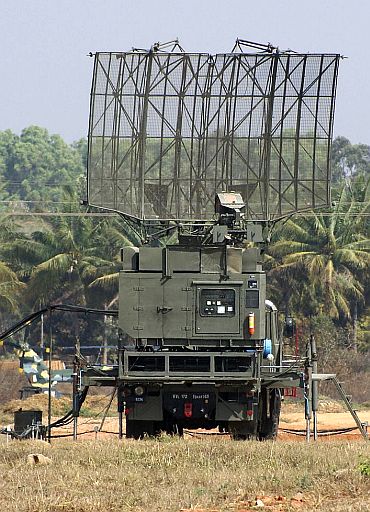
In the past, we have spoken about critical gaps in air defence, and gaps in the chain of radars we have within the country or on the borders. What is the situation now?
Generally we have complete coverage at medium and high levels. There is no gap; it is gap-free. It (gap) is only at low levels because the capability of ground-based radars is limited because of the earth's curvature. To fill these gaps we have many other schemes in place. Firstly low-level radars, the medium-power radars, the LLTRS, the LLWRs -- they fill in the low-level gap.
We have, we have aerostats, which actually raises the platform of the radar increasing the range of the radar. Most of them are on track and 2012 onward, they will start ramping up. In fact, the first medium-powered radar Naliya-I was inaugurated it a couple of weeks back.
What about the air defence systems?
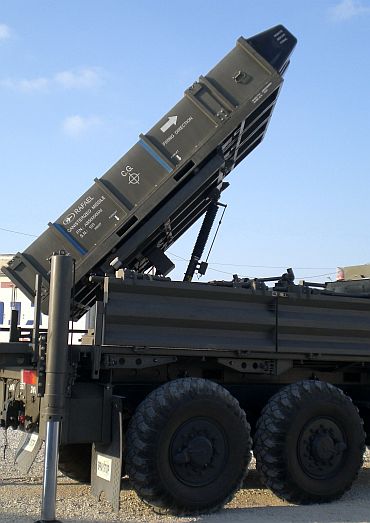
I just want you to elaborate because post-26/11 there was a lot of talk that we have these gaps and even Delhi is not safe. As an Air Chief, I want an assurance from you that none of these scares are a reality?
You have my assurance. You must convince the public that our air defence at the present moment is good, but we want to make it better. At the present moment, I give you an assurance that Delhi is safe.
Let me now move away -- a little bit from your current plans and look at the future. There are several threats in the neighbourhood as we know and you have spoken in the past; you don't want to be adversary specific but a capability-based force. Towards that end, how are you progressing? How are you looking at the future?
Being a part of the services -- all the three services do an exercise. We assess all the threats around our region -- that means it can be a person, it can be a country, it can be anything, it can be an organisation. Anything that that impedes the growth of our country is a threat.
Thereafter we decide on what capability we require based on the strategic decisions taken by the country's leadership. Our zone of interest, our political leanings, various other factors come into this.
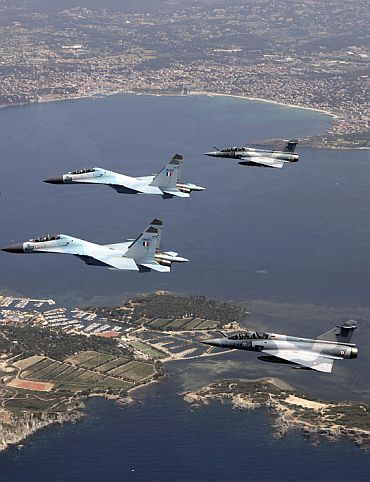
Thereafter we decide what capability by which year we should acquire. Then we go towards procuring that capability. Now in the years to come, our Air Force needs to meet the aspirations of the country.
From the Gulf of Hormuz to the Malacca Straits, as the Prime Minister has pointed out, we must have the range, we must have the capacity to reach these vast distances. And we must have the capability to carry out what is known as net-centric warfare because that is the warfare of the future. You cannot do it isolated.
Once we have the net-centricity, the sensor to shooter time reduces and your reaction is very fast. So that is the future that I am looking at in about 8-10 years time.
Are we looking at China more closely? Is our readiness towards or against China?
You know, many people ask me this as a very serious question. We have always looked intently at every threat, not only China or Pakistan. But as I told you, as a military mind, you assess all the threats. We call it the appreciation method.
Each and every threat is listed and a threat is anything that impedes the progress of the country, and we look at it closely. We look at things very, very closely and give the required inputs to the leadership.

Coming back to the MAFI and the 30 airfields you are upgrading and modernising, are we also looking at a series or a network of airfields in say Ladakh or Arunachal Pradesh?
Yes, we are. In the North East, it is long overdue. We have a major drive on to modernise all the ALGs (Advance Landing Grounds). We have 8 ALGs, including Pasighat, Along, Menchuka, which are being modernised.
Airfields, which are already existing in Chabua, Mohanbari, Jorhat, Guwahati, Bagdogra, Hashimara and Tezpur are being modernised. And down south, all these things are already under hand. They are on fast-track. There is an empowered committee, headed by the Vice Chief, which is looking into the operationalisation and modernisation of these.
As far as the western sector is concerned, Nyoma, DBO -- that is a Phase 2 plan for which action has already started and these will also be brought up to the upgraded standard.
Are there plans to have fighter air bases at Nyoma and Leh?
We will have to see that. A study is going on at the moment. But for transport airport and helicopters, definitely. Thereafter we will evaluate if it is fit for fighters and then decide.

Now let me come back to another issue -- about use of Air Force in anti-Maoist operations. At this moment, where does it stand?
See, use of the Indian Air Force in anti-Maoist operations is the government's prerogative and we are doing that. What you want to know is if there is any offensive use of the IAF. My views remain the same. After all, it is our own people. Intelligence is unavaliable 120 per cent, which is required. There is likely to be collateral damage.
So I will not visualise in the near future offensive use of the Air Force. It is already being used for roles like insertion, extraction, CASEVAC (casualty evacuation), recces, surveillance. And it will I think continue to be used for these purposes.
You recently pulled out all your helicopters from the UN Peacekeeping Mission in Congo, and they are not very happy about it. What was the reason?
It was the requirement for our country. Helicopters are used basically to support the Army in forward areas. And now, it is more and more being used in urban warfare as well -- internal situations against the Maoists, Naxalites, etc. We didn't have the helicopters, although we are getting some, but they are yet to be ramped up. So the only way to do it was to pull out from Congo.

The IAF also does a lot of behind-the-scenes and away-from-peoples'-gaze work. A lot of humanitarian operations in floods and disasters. Do you see even that role being increased?
I think that role will remain the same. We are already doing considerable work. We do not have the resources, but we still give it our best because after all it is saving your own citizens. There have been some very great rescues that have been carried out. One has been carried out by my predecessor on the Timber Trail (near Shimla).
There are always floods along the Ganges, there are always floods down south because suddenly unseasonal rains cause floods and everywhere -- the Air Force is the first to go. You want to ferry troops, you need the Air Force. You want to ferry boats, you need the Air Force. You want to rescue, you want to drop packets, if there is an earthquake you need the Air Force.
In fact, in the earthquake that happened in Pakistan and in our adjourning parts of Jammu and Kashmir, the Air Force did a hell of a lot of work. During the flash floods in Leh, the airfield there was unusable. Army and the Air Force together got that airfield up with just about 12 hours, which was a very great accomplishment.

You are looking at a very modern Air Force. Are you getting the required technical manpower? Is the best of the technical talent coming to you? Or is it that you are trying to make special efforts to bring them in?
The intake has improved a little bit, but it is still not upto the desired standards. So we are taking various measures to make sure that the intake improves. We are taking them before the 12th standard, before their degree, we are giving them a degree in the Air Force.
We are approaching various regions to find new talent. Basic thing is training and retaining them after their induction. These are the two areas where we are giving our focus. And it is being emphasised everywhere that absorption of new technology and converting the operationalisation of new technology is the need of the hour. So our training patterns have been suitably modified. The training itself is being ramped up. All of this will take a little time.
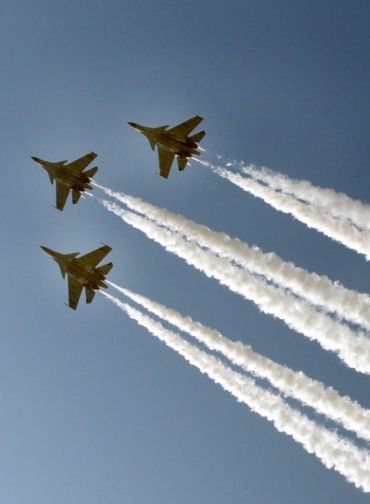
Let me take your views as Chairman, Chiefs of Staff Committee. What are your views on CDS (Chief of Defence Staff)? What do you think should happen to CDS?
You know the Air Force has been maligned quite badly over a lot of years. They feel that the Air Force doesn't want the CDS. On the contrary, the Air Force is very much in favour of the CDS. The point is I do not want a CDS in the present form. That means you make a 3-star, 4-star, 5-star head of IDS, which is an existing organisation and call him CDS, you cannot do that.
If there is a CDS -- in my opinion and this is the Air Force opinion -- that he has to be the single point of military contact to the Raksha Mantri. Are we ready to do that?
Second point: what role model of CDS do we want? There are different role models all over the world. In the American role model, he controls all operations of all the three services and he is answerable to the President directly.
In the Australian model, the Defence Secretary and the CDS are at par. There are other models where CDS only looks after training and acquisition. So we have to decide what model do we want. The third issue is, do we need a change just because everybody else has a CDS? Now since 1947, we have done pretty well.
In 1947, 1965, 1971 and Kargil operations, despite what people say, I think there was a considerable amount of synergy involved. Even today, when we go down to the field levels, that is command level, station level, you find a tremendous amount of synergy between the Army, Navy and the Air Force. So do we need a CDS? That is a basic question. In my opinion, I don't think we need a CDS for the next 5-10 years.
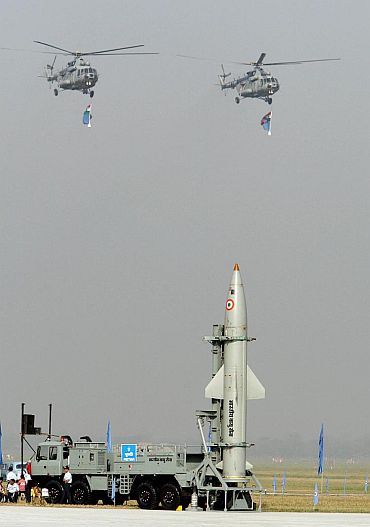
Do you think India needs to develop credible missile deterrents? Especially because of what China is doing? The distances should improve, the range should improve, do you think?
I feel we are developing the capability to have long-range missiles. This development of capability should never be stopped because 10-15 years from now, when you want it, it will not be available. So the capability development must continue.
As far as weaponisation is concerned, that is the government's prerogative. Depending on the geo-politics, they will decide on what distance and what weaponization is important. But capability build-up must continue.
Are you happy with what DRDO is doing? The missile programme?
That has been one of our most successful programmes.